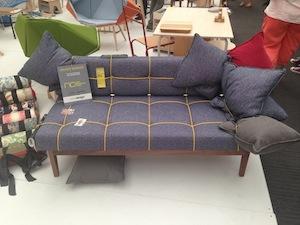It’s always exciting to see what is new in the world of design, and how much it progresses from year to year. In a world where some of those in the know believe that art has evolved as far as it can, design continues to grow, becoming more and more sophisticated, largely due to the demands of the ever-changing world around us. Henceforth, the environment, and our awareness of how much it is changing - teamed with our desire to conserve it - seems to be at the forefront of the majority of product and 3D design. Seeing the ideas of the freshly graduated design students of the UK, all in one place, was always going to be slightly overwhelming, but on this scorching day in July, I made my way to the Business Design Centre in Islington, London, for an afternoon of what promised to be a melting pot of innovation and intelligent design. Here I choose just four of these talented individuals’ work as an example of what was on offer.
First up is James Dart’s project ‘Spar’, which as Dart puts it is “… an interconnecting shape, used to make simple structures”. What is perhaps more interesting though, is the material used is essentially unique to Dart’s work. He has taken a bio-resin base – which is a costly material to use by itself - and mixed it with various types of natural oils to produce a type of foam, which thus reduces the amount of material needed, therefore making it more cost effective. Not only has he produced what could be a new building material, but it is also renewable, so therefore less harmful to produce. The concept design that Dart had on display was in chair form, and as can be seen in the picture, looks a lot like grown-up Meccano, but from what I now know about the structure, is far more advanced.

Following on from the theme of creating new materials, Elea Nouraud’s project ‘TRUC’ celebrates the reuse of disposable super market carrier bags - which are made of polyethylene. The products Nouraud creates vary from domestic objects, to a bag made of carrier bags. With conservation at the heart of Nouraud’s work, the method in which she produces the objects seems to turn the method of producing the carrier bags in the first place, on its head: the disposable carrier bag becomes a durable shopping bag; and the thin, flimsy material of the bags is adjusted to become robust, making it a more useful material, with more longevity than just the weekly food shopping. Even Nouraud’s business card is made using the same process, having the text ‘1BAG’ printed in the corner of each one. Patrick Bateman would be jealous.

The concept behind Leala Dymond’s ‘Bungy’ sofa is that the elastic bungy ropes act as part of a system that allows the user to change the structure of the sofa, by arranging the cushions according to their own preference of what is comfortable. They can also be used to store objects, such as remote controls and magazines. Whilst chairs of this nature are usually not designed to be aesthetically pleasing (see LazyBoy as a shining example), Dymond’s design is as pleasing on the eye as it is on the user’s body. It was also winner of the 100% Design award, which means this sofa with be exhibited at the show later this year. Hopefully we will be able to arrange our very own Laela Dymond cushions to our liking in the near future.

The last design that caught my eye was Henry Franks’ ‘Bog Standard’ – an amusing hybridization of two of the most popular bathroom accessories: the toilet seat and the toilet roll-holder. Designed as a response to a brief based on humour and everyday objects, the intention of the design was simply to put a smile on people’s faces, though I couldn’t help but think that this was much more than just a novelty; how many loo roll-holders has the average person ripped off the wall, with just the ugly brackets left in their place? Or is that just me? Either way, this ingenious idea - which may well appear to be very simple - is one of those where the viewer ends up asking themselves “why didn’t I think of that?” But then that was probably the most common question in the building that day.

Review by Dante Holdsworth